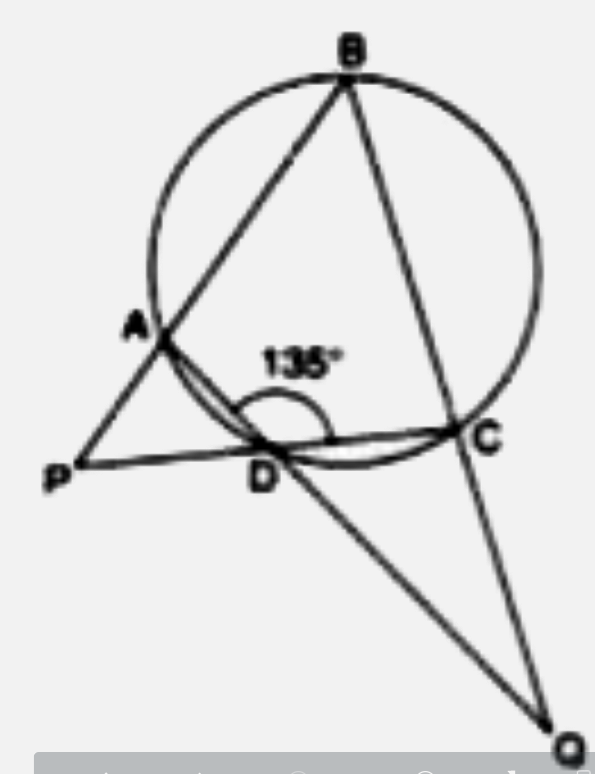ABCD is a cyclic quadrilateral , Sides AB and DC produced meet at point E , whereas sides BC and AD produced meet at point F.
If ∠DCF:∠F:∠E=3:5:4 find the angles of the cyclic quadrilateral ABCD.
The correct Answer is:∠A=36∘,∠B=84∘,∠C=144∘and∠D=96∘
To solve the problem, we will follow these steps:
Step 1: Define the Angles
Given the ratio of angles ∠DCF:∠F:∠E=3:5:4, we can express these angles in terms of a variable x:
- Let ∠DCF=3x
- Let ∠F=5x
- Let ∠E=4x
Step 2: Identify Vertical Angles
Since ∠DCF and ∠DAB are vertical angles, we have:
- ∠DAB=∠DCF=3x
Step 3: Find Angle DCB
Since ∠DCF=3x and ∠DCB is on the same straight line as ∠DCF, we can find ∠DCB:
- ∠DCB=180∘−∠DCF=180∘−3x
Step 4: Apply the Cyclic Quadrilateral Property
In a cyclic quadrilateral, the sum of opposite angles is 180∘. Therefore:
- ∠DAB+∠DCB=180∘
- Substituting the angles we have:
3x+(180∘−3x)=180∘
This equation is satisfied, confirming our angles are consistent.
Step 5: Find Angle AFB
In triangle AFB, the sum of the angles is 180∘:
- ∠A+∠B+∠F=180∘
- Substituting the angles:
3x+7x+5x=180∘
This simplifies to:
15x=180∘
Step 6: Solve for x
Now, we solve for x:
x=180∘15=12∘
Step 7: Calculate the Angles
Now we can find the angles of the cyclic quadrilateral:
- ∠A=3x=3×12∘=36∘
- ∠F=5x=5×12∘=60∘
- ∠B=7x=7×12∘=84∘
- ∠C=180∘−∠A=180∘−36∘=144∘
- ∠D=180∘−∠B=180∘−84∘=96∘
Final Angles of the Cyclic Quadrilateral
Thus, the angles of the cyclic quadrilateral ABCD are:
- ∠A=36∘
- ∠B=84∘
- ∠C=144∘
- ∠D=96∘
Given the ratio of angles ∠DCF:∠F:∠E=3:5:4, we can express these angles in terms of a variable x:
- Let ∠DCF=3x
- Let ∠F=5x
- Let ∠E=4x
Since ∠DCF and ∠DAB are vertical angles, we have:
- ∠DAB=∠DCF=3x
Since ∠DCF=3x and ∠DCB is on the same straight line as ∠DCF, we can find ∠DCB:
- ∠DCB=180∘−∠DCF=180∘−3x
In a cyclic quadrilateral, the sum of opposite angles is 180∘. Therefore:
- ∠DAB+∠DCB=180∘
- Substituting the angles we have:
3x+(180∘−3x)=180∘
This equation is satisfied, confirming our angles are consistent.
In triangle AFB, the sum of the angles is 180∘:
- ∠A+∠B+∠F=180∘
- Substituting the angles:
3x+7x+5x=180∘
This simplifies to:
15x=180∘
Now, we solve for x:
x=180∘15=12∘
Now we can find the angles of the cyclic quadrilateral:
- ∠A=3x=3×12∘=36∘
- ∠F=5x=5×12∘=60∘
- ∠B=7x=7×12∘=84∘
- ∠C=180∘−∠A=180∘−36∘=144∘
- ∠D=180∘−∠B=180∘−84∘=96∘
Thus, the angles of the cyclic quadrilateral ABCD are:
- ∠A=36∘
- ∠B=84∘
- ∠C=144∘
- ∠D=96∘
Topper's Solved these Questions
- CIRCLESBOOK - ICSECHAPTER - CIRCLESEXERCISE - EXERCISE 17(B)
10 Videos
- CHAPTERWISE REVISION EXERCISEBOOK - ICSECHAPTER - CHAPTERWISE REVISION EXERCISEEXERCISE - CHAPTERWISE REVISION EXERCISE (PROBABILITY)
16 Videos
- CONSTRUCTIONS (CIRCLES)BOOK - ICSECHAPTER - CONSTRUCTIONS (CIRCLES)EXERCISE - EXERCISE
39 Videos
Similar Questions
In a cyclic -quadrilateral PQRS angle PQR =135∘ , Sides SP and RQ produced meet at point A whereas sides PQ and SR produced meet at point B. If ∠A:∠B=2:1. find angles A and B
View SolutionABCD is a syclic quadrilateral with ∠ADC=135∘. Sides BA and CD produced meet at point P, sides AD and BC produced meet at point Q.If∠P:∠Q=2:1, find angles P and Q.

View SolutionABCD is a cyclic quadrilateral. ABandDC are produced to meet in E. Prove that EBC~EDA.
View SolutionIf ABCD is a cyclic quadrilateral, then prove that AC.BD=AB.CD+BC.AD
View SolutionABCD is a cyclic quadrilateral in which AB and DC on being produced , meet at P such that PA = PD. Prove that AD is parallel to BC .
View SolutionABCD is a cyclic quadrilateral (see Figure). Find the angles of the cyclic quadrilateral.
View SolutionIn a cyclic quadrilateral ABCD ∠A:∠C=3:1and angle B : angle D = 1 : 5 find each angle of the quadrilateral
View SolutionThe sides AB and DC of a cyclic quadrilateral ABCD when produced meet at E and the sides DA and CB when produced meet at F. Given ∠BEC=38∘,∠BAD=102∘. Find the values of ∠AFB and ∠ADC.
View SolutionIn quadrilateral ABCD, AB=DC and AD=BC. Prove that the sides AB and DC are parallel to each other.
View SolutionABCD is a quadrilateral in which AB=BC and AD=CD ,Show that BD bisects both the ∠ABC and ∠ADC.
View Solution
